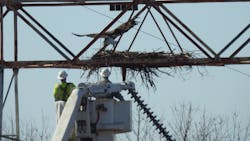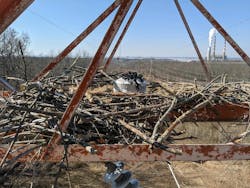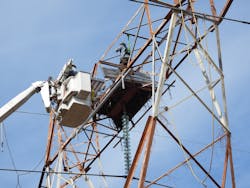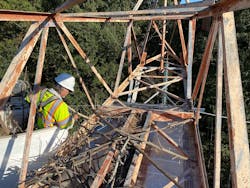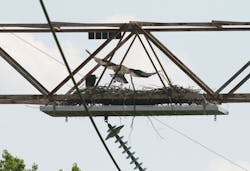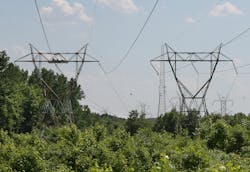Protecting Power Lines and Birds of Prey
On a chilly February morning in 2021, a phase-to-ground trip was initiated near the banks of the lower Potomac River in southern Maryland. The substation breakers quickly restored the 230kV transmission line to full operation; however, the connecting stations service large critical customers, where any power interruption would be unwelcomed.
Pepco field investigators quickly tracked the fault to the 908E lattice tower, where wet sticks from an untidy nest dangled precariously above the center phase. The ongoing threat to reliability was indisputable, and the culprits were bald eagles. With their unkempt nests and heedless defecation habits, it is difficult to reconcile the sublime majesty of our national bird with their notoriety as problematic tenants.
A Breeding Pair on the Loose
This eagle pair already had a reputation in the neighborhood. They had previously nested in a cellular antenna attached to a nearby transmission tower before the communication company permitted and executed a nest eviction at the end of the breeding season. In October 2020, the pair was tracked to a nearby transmission tower and Pepco was alerted to a tentative nesting attempt. All signs indicated these eagles were undaunted by the loss of their nest, determined to retain their breeding territory, and partial to engineered structures.
The situation was increasingly familiar to Pepco’s avian program manager, Cristina Frank. Once federally listed as endangered due to environmental contamination by the insecticide DDT, the bald eagle is an Endangered Species Act (ESA) success story. From just 60 breeding pairs in the 1970s, the Chesapeake population of bald eagles rebounded strongly thanks to a ban on DDT, robust regulatory protections, and focused restoration efforts. The Chesapeake population grew from nearly 650 breeding pairs in 2001 to 3,000 pairs in 2020, an annual increase of 8% to 10%.
The bald eagle was delisted under the ESA in 2007, though stringent Bald and Golden Eagle Protection Act safeguards remain in place. Today, bald eagles are a common sight in the coastal Mid-Atlantic states, where habitat is exceptional and foraging opportunities abound. In fact, eagles have become so common that they vigorously compete with one another for breeding territories and prime nest sites — trees and snags with sparse branches, commanding views, and access to open water with abundant fish.
Over the last decade, many breeding pairs have discovered that a transmission tower is a fine substitute for a tree. Transmission operators may dispute such a determination: High-voltage clearances are large enough to protect eagles from electrocution, but sometimes too small to protect the system from eagles. Studies by Pepco and its sister utilities in the region have shown that nest-related outages caused by eagles and other large birds are a legitimate operational concern, and Pepco is acutely aware that such outages also pose a risk of wildfire ignition.
Nest Response Planning
Eagle nests are protected year-round. Unlike most species, a federal permit is required to remove an eagle nest, even outside the breeding season. In the case of the 908E tower, emergency monitoring revealed an additional sensitivity: The pair had already laid an egg, meaning the nest was demonstrably “in-use.” In response to an early briefing, the U.S. Fish and Wildlife Service (USFWS) cautioned: “Securing a permit for removal of an in-use nest is a process, and not to be taken lightly.” As a result, Frank and the Pepco team resigned themselves to a minimally intrusive stopgap measure. According to the terms of the USFWS Eagle Nest Take permit Pepco received, they could only trim the nest sticks posing the greatest outage risk, and they could do so just once during the breeding season.
Frank led the long-term planning effort for the 908E nest, working with wildlife-power line interaction specialists EDM International, Inc. (EDM) to refine three management alternatives. The first was scheduling an annual nest trimming outside the breeding season to reduce both the number of sticks that would break loose and the likelihood of a related outage. The second was relocating the nest to an engineered platform mounted lower on the tower or at the edge of the right-of-way. The third option, “nest containment,” was more innovative: installing a tray beneath the existing nest to collect unstable material and to prevent sticks from falling into the conductor zone.
What to Do?
The decision-making process was closely informed by two prior experiences managing eagle nests on lattice towers. Relocation and removal both required lengthy permitting efforts, mandatory mitigation, armoring towers with large bird spikes, and ongoing monitoring. Additional labor was needed to track and haze nest attempts on unprotected structures. These operations were resource-intensive: one-year costs ranged from $220,000 to nearly $400,000. Another drawback was the recognition that relocating a nest does not guarantee its use, since eagles could instead select any unprotected tower nearby. Annual nest trimming was unappealing because it would require a new permit each year, and because success would be uncertain. After all, a storm could blow even a trimmed nest into the conductors.
Nest containment was the alternative deemed most likely to prevent future outages. A tray mounted below the nest would prevent stick-related service interruptions, and allow the eagles to retain their preferred site would preempt a fruitless chase from tower to tower in subsequent breeding seasons. Direct costs would be far lower than the alternatives if the containment tray could be affordably fabricated and efficiently installed. Unlike the alternatives, containment had the potential to be a scalable eagle nest management alternative.
Although a permit would be initially necessary, if eagles were not negatively impacted, and containment could be implemented outside the breeding season with no disturbance to nesting materials, a federal permit might eventually become unnecessary. In the absence of a permit, there would be no mitigation or monitoring requirements, further streamlining the process. The potential upside of nest containment was extraordinary, and Pepco stakeholders were excited to carry out a proof of concept.
Nest Containment
Containment was an intriguing concept, but not a proven practice. The first containment pilot project in 2017 ended in failure when a mesh panel tore loose in a storm and had to be removed. This time around, Pepco needed a bomb-proof tray that could be installed from below the bridge without disturbing the nest and accommodate uncertainty in the tower’s dimensions.
Frank and EDM had previously worked with independent line contractor AUI Power (AUI) to develop avian mitigation for a thorny switch problem. AUI had impressed Pepco with their ability to understand the problem and quickly develop and fabricate a solution their own personnel could install under difficult conditions. Why not rely on field experts to design and implement a nest containment solution that would be practical to install and stout enough to meet Pepco’s loading requirements?
“This is going to be a complex install with a lot at stake,” explained Moir, “but because the linemen and the Fab Team worked out the kinks on the training yard tower, we are confident we will stick the landing.”
Pepco’s confidence in AUI was rewarded in the fall of 2021. Although most of the 908E nest had fallen through the bridge by July, eagles had placed several new sticks by September, and Pepco proceeded with the planned October outage. Resident eagles supervised the beginning of the six-hour installation from a nearby tower. Once the containment tray was secured, David Smith, a wildlife biologist from Coastal Resources, Inc., tutored the AUI linemen in building a rudimentary starter nest on the bridge from scavenged sticks.
“The scientific literature describes this as ‘augmenting the odds of anthropogenic nest site adoption,’ but it’s more fun to imagine rolling out the red carpet for honored guests,” Smith said.
The 908E installation went smoothly, but a nearby osprey nest provided a better test, weeks later. Instead of removing it outside the breeding season, Frank decided to retain and contain the osprey nest, offering the eagles a ready-to-use alternative to the 908E site. Though the osprey nest was bulky and dense, the AUI crew was able to install the containment tray in less than three hours, with minimal disturbance. Security chains were added to the tray as a redundant safety measure to protect the insulators and conductors in a worst-case scenario. AUI’s design was proven to be practical to install and robust, but success hinged on the next question: How would the eagles respond?
Conclusions
This pilot project demonstrated that nest containment, carefully implemented by an expert team with diverse and complementary skill sets, can be mutually beneficial for all parties. For the eagles, containment provides additional security, allowing them to retain a favored nest site and reducing the likelihood that a successful nest will be lost to a storm. For transmission operators, containment protects reliability and reduces safety risks, at a cost estimated to be 90% lower than nest removal. For regulators, containment reduces conflict between humans and protected wildlife while offering distinct advantages to each. Containment is a win-win-win.
The fledging of two juvenile eagles from a contained nest represents a conservation success and a system-hardening triumph. From a reliability perspective, a mitigated eagle nest in a known location is far preferable to an unsettled pair that might build a hazardous nest on any unprotected lattice tower. Pepco is committed to providing safe, reliable and affordable power, being a good environmental steward and fulfilling the company’s regulatory obligations. Innovation, creativity, and adaptability have allowed Pepco to fulfill these commitments in the past, and will remain vital to serving homes and businesses in some of the finest bald eagle habitat anywhere. Once a rarity, eagle nests on transmission towers have become commonplace. To the benefit of the eagles and operators, customers and regulators, Pepco believes that nest containment will one day be seen as an important chapter in the bald eagle recovery story.
Duncan Eccleston ([email protected]) is project manager at EDM International, Inc. in Fort Collins, Colorado. He works at the intersection of wildlife, overhead power systems, service reliability, regulatory compliance, and wildfire prevention across the U.S. and abroad. He holds a B.A. from Middlebury College and an M.S. from Colorado State University.
Cristina Frank ([email protected]) is an environmental program manager at Pepco Holdings in Newark, Delaware. Cristina is a Certified Wildlife Biologist managing the company’s Avian Protection and Management Program, a comprehensive, science-based program implemented to minimize and avoid avian and other wildlife interactions with utility infrastructure while improving service reliability. She holds a B.S. in Natural Resource Management and a M.S. in Ecology from Rutgers, the State University of New Jersey.
Benjamin S. Jessup ([email protected]) is manager, Engineering Transmission Reliability at Pepco Holdings in Washington, D.C. He specializes in corrective maintenance and transmission standards for overhead and underground transmission applications. He received a BSME degree and a master’s degree in materials science engineering from the University of Virginia and is a member of ASTM International and NACE International.
Libby Mojica ([email protected]) is a certified wildlife biologist at EDM International, Inc. in Fort Collins, Colorado. She finds solutions to bird management challenges in the electric industry using science to guide management recommendations to minimize nesting, electrocution, and collision conflicts. She has a B.S. from Trinity University and a M.S. from The University of Georgia.
For More Information
EDM International | http://edmlink.com
Eagle Egg Microclimate
In March 2021, Pepco had an urgent need to prevent another power interruption by trimming high risk sticks from the 908E nest, but eagle nest management or disturbance requires a federal permit. A sticking point for the U.S. Fish and Wildlife Service was the presence of an egg: regulators were concerned that if the adults left the nest for an extended period, the exposed egg would cool beyond the point of viability. Weather conditions in early spring are unlikely to be ideal, but a nest trimming outage requires advance planning.
Cristina Frank, Pepco’s Avian Program Manager, secured the necessary permit with an innovative proposal to maintain a viable egg temperature and protect the egg from physical disturbance during nest trimming. Conceived and developed specifically for this project by EDM International, Inc., the prototype Eagle Egg Microclimate (EEM) consisted of an insulated 18-inch protective dome, a thermostat-controlled heating pad, and a power bank. An ancillary remote thermometer allowed observers to monitor the interior temperature of the EEM from the ground.
On the morning of the nest trimming the air temperature was 52°F, too low for an eagle egg to withstand for long. The female eagle remained in her incubation posture until the linemen were nearly eye-to-eye, then flew off, allowing them to carefully place the EEM over the egg. The EEM quickly increased the temperature near the egg by more than 20°F, affording the crew ample time to safely complete the nest trimming. When the crew returned to the ground, the female immediately returned and resumed incubation. The egg hatched in April and the young bald eagle made its first flight in June. Shared successes like the EEM build a foundation of trust between operators and regulators, enabling them to respond more effectively and cooperatively to wildlife challenges.
Permitting Process
In preparation for this pilot project, Pepco secured a U.S. Fish and Wildlife Service (USFWS) Eagle Nest Take permit, which authorized emergency nest trimming during the breeding season, followed by containment tray installation outside the breeding season. This was a “specific permit” authorizing explicit activities and requiring a unique suite of mitigation actions, both tailored to the situation at hand.
In September 2022, USFWS proposed modifications to the Bald and Golden Eagle Protection Act that would create a “general permit” scheme for Eagle Nest Take and Disturbance Take. With a goal of reducing the eagle permitting burden for the Service and applicants, a general permit with generic “best practices” mitigation requirements would be issued automatically upon the completion of an online form and payment of a reasonable fee. At the time of this writing, it is uncertain whether the general permit system will be finalized, and if so, the specific application and reporting procedures.
With these uncertainties in mind, it will be essential for any utility considering eagle nest containment to discuss the permitting process directly with their regional USFWS Migratory Birds Permit Office. Utilities also are invited to contact the authors of this article for additional eagle nest containment information.
About the Author
Cristina Frank
Cristina Frank ([email protected]) is an Environmental Program Manager at Pepco Holdings in Newark, Delaware. Cristina is a Certified Wildlife Biologist managing the company’s Avian Protection and Management Program, a comprehensive, science-based program implemented to minimize and avoid avian and other wildlife interactions with utility infrastructure while improving service reliability. She holds a B.S. in Natural Resource Management and a M.S. in Ecology from Rutgers, the State University of New Jersey.
Duncan Eccleston
Duncan Eccleston ([email protected]) is Project Manager at EDM International, Inc. in Fort Collins, Colorado. He works at the intersection of wildlife, overhead power systems, service reliability, regulatory compliance, and wildfire prevention across the U.S. and abroad. He holds a B.A. from Middlebury College and an M.S. from Colorado State University.
Libby Mojica
Libby Mojica ([email protected]) is a Certified Wildlife Biologist at EDM International, Inc. in Fort Collins, Colorado. She finds solutions to bird management challenges in the electric industry using science to guide management recommendations to minimize nesting, electrocution, and collision conflicts. She has a B.S. from Trinity University and a M.S. from The University of Georgia.
Benjamin Jessup
Benjamin S. Jessup ([email protected]) is Manager Engineering Transmission Reliability at Pepco Holdings in Washington, D.C. He specializes in corrective maintenance and transmission standards for overhead and underground transmission applications. He received a BSME degree and a master’s degree in materials science engineering from the University of Virginia and is a member of ASTM International and NACE International.
